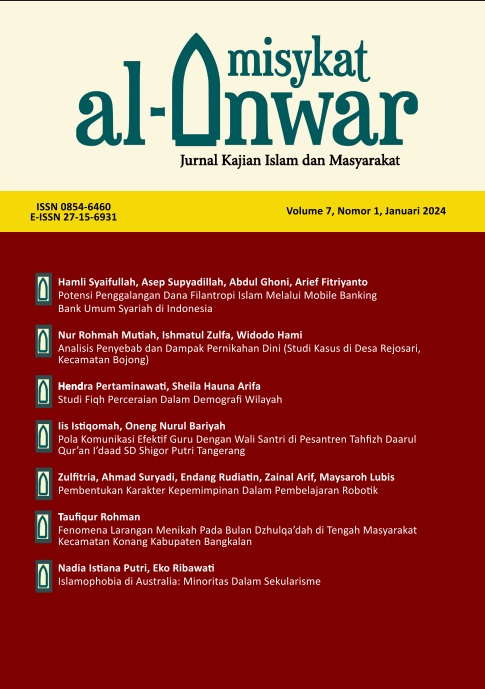POLA KOMUNIKASI EFEKTIF GURU DENGAN WALI SANTRI DI PESANTREN TAHFIZH DAARUL QUR’AN I’DAAD SD SHIGOR PUTRI TANGERANG
Main Article Content
Abstract
Article Details
All manuscripts published in the Misykat al-Anwar Journal of Islamic Studies and Society are entirely the property of the author, as for the entry and unpublished script of the journal, the copyright is wholly the property of the author.
All manuscripts published in the Misykat al-Anwar Journal of Islamic Studies and Society are open to the public by following the provisions of the CC-BY-NC-SA (Attribution Non Commercial Share Alike) platform where everyone is allowed and permitted to adapt, the results of the study with the provision should provide citation credit to the author (citation) not for commercial purposes, and one must make a similar provision to the results of his research.
---
Semua naskah yang diterbitkan dalam Misykat al-Anwar Jurnal Kajian Islam dan Masyarakat sepenuhnya menjadi hak milik penulis, adapun naskah yang masuk dan belum diterbitkan oleh jurnal, hak cipta sepenuhnya milik penulis.
Semua naskah yang diterbitkan dalam Misykat al-Anwar Jurnal Kajian Islam dan Masyarakat terbuka untuk umum (open access) dengan mengikuti ketentuan platform CC-BY-NC-SA (Attribution Non Commercial Share Alike) semua orang diperbolehkan untuk menyadur, merujuk dan mengadaptasi tulisan/hasil penelitian dengan ketentuan harus memberikan kredit rujukan kepada penulis (citation) bukan untuk kepentingan komersial, dan seseorang harus melakukan ketentuan yang serupa terhadap hasil penelitiannya.
References
Djamarah, Syaiful Bahri. (2004). Pola Komunikasi Orang Tua & Anak Dalam keluarga, Jakarta: PT. Reneka Cipta
Effendy. Onong Uchjana, (2019). Ilmu Komunikasi Teori dan Praktek Bandung:Remaja Rosda Karya, Cet. Ke-28.
Evert, Daniel Paulus. (2020). “Komunikasi Interpersonal Dalam Konsultasi Dokter Estetika Dengan Pasien Melalui Media Sosial Whatsapp” , dalam Buana Komunikasi Jurnal Penelitian & Studi Ilmu Komunikasi Volume 01 Nomor 02, 127- 136 Bandung, p-ISSN : 2774 - 2342 e-ISSN : 2774 - 2202
Hardjana, Agus M. (2007). Komunikasi Intrapersonal & Interpersonal, Yogyakarta: Penerbit Kanisius, Anggota IKAPI, Cet. Ke-5
Hermanto, Lubis, (2016)“ANALISIS POLA KOMUNIKASI INTERPERSONAL (Studi Antara Masyarakat Pendatang Dengan Masyarakat Lokal Di Desa Boro Kecamatan Sanggar Kabupaten Bima)” dalam Jurnal Komunikasi & Kebudayaan. Volume III Nomor 1 Januari-Juni , 55-68
al-Malik Fahd Ibnu ‘Abdu Al-Aziz Al-Saud, Al-Qur’an dan Terjemah, Medinah Munawwaroh, Kerajaan Saudi Arabia
Mufid, Muhamad. (2010). Komunikasi & Regulasi Penyiaran, Jakarta: Kencana Prenada Media Group
Mulyana, Deddy. (2021). Ilmu Komunikasi Suatu Pengantar. Bandung: PT. Remaja Rosdakarya. Cet. Ke- 21
Ngalimun & Harles Anwar. (2016). Ilmu Komunikasi: Sebuah Pengantar Praktis, Banjarmasin:Pustaka Banua
Nofrion. (2019), Komunikasi Pendidikan; teori dan Konsep Komunikasi Dalam Pembelajaran, Jakarta: Kencana
S. Margono, (2013), Metodologi Penelitian Pendidikan. Jakarta: Rineka Cipta.
Topan Setiawan, Fammy Hendro Aro Putro. (2021). “Komunikasi Efektif Dalam Membina Keterampilan Berwirausaha Di Pc Ipnu Kabupaten Boyolali” dalam INTELEKTIVA : JURNAL EKONOMI, SOSIAL & HUMANIORA , E-ISSN 2686 5661 VOL.2 NO. 08 – MARET, 100-107
Wawancara Penulis dengan informan Orang Tua Santri
Wawancara Penulis dengan Informan Pengjara Pesantren Tahfizh
Website :“Driving Directions to Pesantren Tahfizh Daarul Qur’an Shigor Putri WAZE”,https://www.waze.com/ur/live-map/directions/indonesia/banten/pesantren-tahfizh-daarul-quran-sighor putri?to=place.ChIJDf4NJLX-aS4R2nqYF8krMdM,
